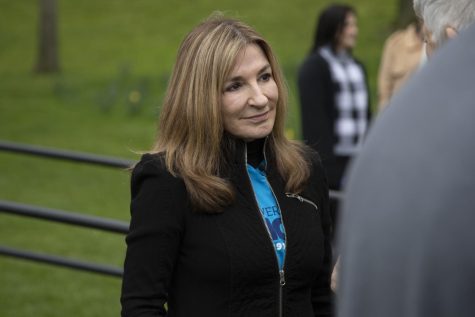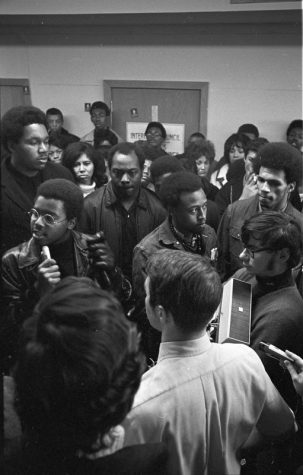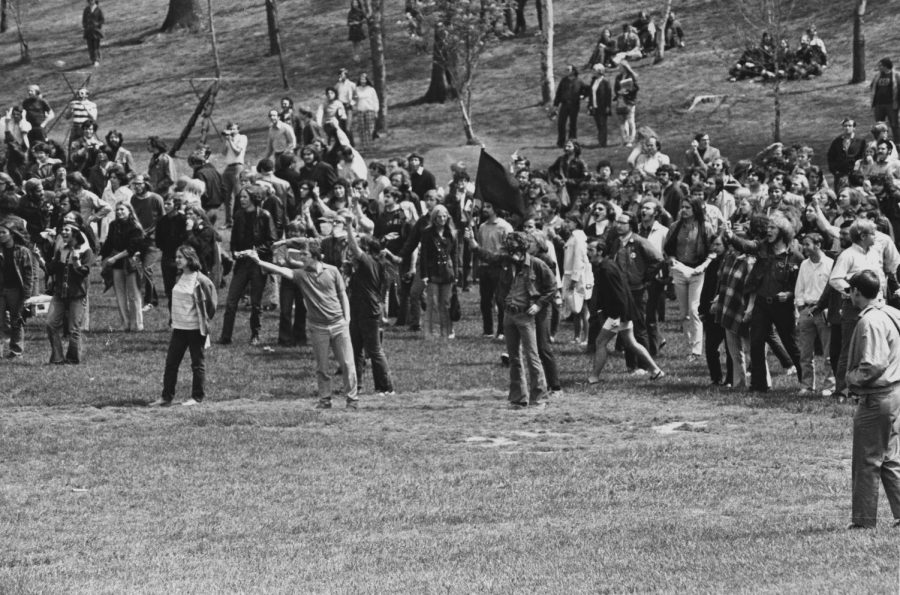May 4: A legacy of student activism on campus
Kent State University News Service
Protesters crowd the edge of the Commons below Taylor Hall as they shout and gesture at National Guardsmen during the disturbances on the Kent State campus May 4, 1970. At left, in a cowboy-style shirt and wearing a headband, is Jeffrey Miller, who was killed later that day.
May 4, 2023
Kent State’s history of student activism goes back further than May 4, 1970, and will stretch even further into the future, said professor and May 4 survivor, Roseann “Chic” Canfora. She said Kent State has a unique legacy of activism on campus – and when Kent State students take action, the world notices.
Kent State’s activist beginnings
“We really need to dispel the myth that was advanced after May 4, 1970, that it was a surprise that the shootings happened at Kent State, that it was this sleepy little college town and that the state-sanctioned violence that took place here should’ve happened at a Berkley or a Columbia,” Canfora said. “If people know Kent State’s history of student activism, they will learn that Kent State students were very very active in the Civil Rights Movement.”

She said Kent State students marched with John Lewis at Selma in 1965 and sat in at not only segregated lunch counters in the South, but a segregated lunch counter in Kent which was formerly located off of Main Street.
Canfora said Kent State students were also involved in protests on campus before her time at Kent State.
“Kent State students were very active in protesting segregated student housing,” she said. “That was just remarkable to me, to see so much political activism. It was reminiscent only of in my childhood, seeing workers on strike and fighting for better wages, healthcare, safe working conditions. The students at Kent State had that same passion for human rights.”
Kent State in 1970
The Vietnam War began in the late 1940s after World War II, but the United States’ involvement didn’t begin until 1955 when President Eisenhower deployed the Military Assistance Advisory group to South Vietnam to train the Army of the Republic of Vietnam. The U.S. didn’t deploy troops to Vietnam until 1965 under President Johnson. U.S. troops remained in Vietnam until the war’s end with the fall of Saigon in 1975.
The first US draft lottery since WWII was held December 1, 1969. Over two million young men were drafted over the course of the war.
“I moved into Lake Hall as a freshman in 1968,” Canfora said. “Kent was like a lot of college campuses across the country. There was a lot of student activism. A lot of us who attended state universities came from working class families. Many of our fathers were active in the labor movement, many of our mothers were stay-at-home moms, and so it wasn’t unusual to see a lot of political activism around women’s rights and around worker’s rights and among civil rights.”
Canfora, sister of the late Alan Canfora who was injured by a bullet during the May 4 shooting, said her political activism in the anti-war movement didn’t begin until the war became “personal.” It was the death of one of her brother’s closest friends in the war that made her get involved.
“The Vietnam War became very personal to those of us who were between the ages of 18 and 21,” Canfora said. “It was our friends and our family members who were of age, particularly once they instituted the draft. And they were going off to fight in a war that they weren’t even allowed to vote for.”

Eighteen-year-olds did not gain the right to vote in the United States until the 26th amendment in 1971. Canfora said the possibility of her brothers being sent to Vietnam was also a factor in her political activism.
Canfora said during her time at Kent State, Students for a Democratic Society (SDS) was at the forefront of political activism on campus.
Students for a Democratic Society was not unique to Kent State’s campus. The first chapter was founded in 1960 in Ann Arbor, Michigan, by college students opposing the Cold War. By the late ’60s, chapters had spread across the country and became active in the anti-war movement.
“The chapter in Kent had some of the strongest and most impressive, brilliant leaders during that period,” Canfora said. “Even Mark Rudd, who led the protests at Columbia, said that Kent had some of the most active and brilliant student activists, unmatched by any Ivy League school in the country. And those were the leaders of Kent SDS.”
Canfora said she remembers the dedication of members of SDS.
“They were always out leafleting, they always had a bullhorn out, they were always educating their fellow students about the issues of the day,” she said. “I became fascinated by their resilience, their persistence and their passion for causes. And I envied that. I wanted to be part of it. So, they inspired me to join them.”
Christian Heller, chair of SDS and peace and conflict studies major, echoed her sentiments on SDS’s involvement in the late sixties and early seventies.
“SDS was formed in the late sixties at Kent State as kind of an evolution out of the student anti-war movement,” Heller said. “It was organizing around the Vietnam War and bringing our troops home.”
Heller said SDS has a long history of partnership with Black United Students (BUS), one of Kent State’s major student organizations founded in 1968.
BUS, like SDS, has a long history of student activism on campus, Canfora said. She said they were particularly active in protests against the Oakland Police’s recruiting on campus in 1969.
“Both SDS and BUS worked together to keep the Oakland Police Force from recruiting for their racist police force in California on the Kent State campus,” Canfora said.
Heller said they staged a sit-in to protest the police presence.

“One of the biggest things that they were known for was when the Oakland Police Department came to campus to recruit students to the Oakland Police Force,” Heller said. “And at the time and still today, the Oakland Police Department is notoriously a racist organization that brutalized the Black Panther Party. So, SDS in conjunction with BUS, staged a sit-in in the administration building to end Oakland PD from recruiting on campus.”
Heller said after this, members of SDS and BUS faced expulsion from Kent State. As a result, BUS staged a walk-out and got the participation of nearly every Black student on campus. The groups formed a “university in exile” in Akron, Heller said, which eventually led to the university granting total amnesty to the students involved.
“Over the years, SDS became more aggressive in their anti-war actions, and they really got on the bad side of administration,” Heller said. “Several of their members were facing disciplinary hearings, and those hearings were kept secret from the larger student body. Eventually, it came out that they were being held in the Music and Speech building and the students across campus stormed and occupied the building.”
As a result, he said, Kent State’s SDS charter was revoked and several SDS members were arrested and faced trial.
While SDS regained traction nationally in the early 2000s during the Global War on Terrorism, the Kent State chapter did not restart until 2019.
Kent State today
Student activism is still alive on Kent State’s campus, said Heller. He said SDS is a large part of this.
“Our mission is to advocate on behalf of students to administrations, to local government,” he said. “We are centered for students. Specifically on our campus and in the state of Ohio. Every state and every campus has its own struggles.”
Heller said when Kent State’s chapter was re-founded in 2019, one of their demands was to remove Aramark as the campus’s food provider.
“[It was] because of their ties to prison labor as well as various labor violations,” he said. “And we successfully got them off campus.”
SDS’s two other demands upon re-establishment were the bettering of mental health services on campus and increasing the minimum wage.
Heller said in fall 2021, SDS rallied behind the cause of better dining services for students, particularly those with dietary restrictions.
“Food services wasn’t well-run, to say the least. There was raw chicken, and they closed down the Prentice Café, which was the only gluten-free dining hall on campus,” Heller said. “Kent State advertises itself as a very inclusive dietary-friendly campus, and that’s just not true.”
He said though they were unsuccessful, he believes the issues with dining services are directly linked to workers’ wages.
“We believed then as we do now that it was inextricably tied to workers’ wages because of the low pay-rate on campus,” Heller said. “Student workers don’t want to work for dining services. They were so understaffed, that was the predominant issue.”
More recently, he said, SDS has focused on organizing protests after the Dobbs decision was leaked last spring, and then later in the summer when the decision passed in the Supreme Court, which ended the federal right to an abortion in the United States. He said this work continued into the fall.
“Moving into the fall, we wanted to do something about this,” Heller said. “And since Roe v. Wade was overturned, abortion became near nonexistent in Ohio. We wanted to put pressure on the university to be able to do something for students.”
Heller said SDS put out a survey for all students to see what action they wanted the university to take.
“It seemed pretty unanimous among students that the best thing put forward would be a Plan B vending machine,” he said. “But it became clear that a Plan B vending machine would be too difficult to implement, so we came to a compromise to provide Plan B in the Eastway market with nondescript packaging.”
The May 4 task force, a student-run group dedicated to remembering and commemorating the events of May 4, 1970, also takes part in student activism on campus, said Avery Hall.
Hall, who has served as the chair of the task force for two years, said the task force was built on the activism of its predecessors.
“The task force was formed five years after May 4, 1970, in response to the university deciding that they no longer needed to hold these honorarium commemorations for what happened on May 4,” Hall said. “And students, in response to that, formed this organization to ensure that it would never be forgotten on Kent State’s campus. The founding members and those who joined years later have really driven activism through the task force on Kent State’s campus.”
She said the task force has been “instrumental” in obtaining the May 4 Visitor’s Center, commemorations, as well as obtaining memorial status for the events that took place May 4.
“The reason we’ve come this far is because of really relentless student voices that have been a part of this group for decades,” Hall said.
This year, Hall said, the task force chose to focus on gun violence in their May 4 commemoration.
“This year in particular, we’ve centralized our programming on the topic of gun violence,” she said. “Our current task force believes that there are so many parallels between the age of gun violence we live in today and what happened on May 4.”
Although Hall said the task force’s focus is and will always be remembering May 4, they also are vocal on other social causes, like the current Senate Bill 83.
Canfora stressed student activism of the past and present.
“Historically, college students are the ‘conscience of America’,” Canfora said. She said due to its history, Kent State is uniquely situated on the world stage and can serve as an example for other students across the country.
“Our university president always reminds us that the eyes of the world are on Kent State,” she said. “If students at Kent State today engage in the kind of strong, national action that we did in 1968, it is more likely that there will be national attention on that.”
Canfora said she thinks the spirit of activism that was alive in 1968 is still present on campus today.
“I think students today care just as much about the issues that affect their lives normally,” she said. “They are paying attention to how their state and federal legislators are voting on the issues that affect them: student loan debt, student loan forgiveness, healthcare, climate, abortion rights.”
Canfora said she sees student activism every day on campus.
“Every day, whether I’m seeing students down by Manchester Hall with the petition for transgender rights or students on the commons registering young people to vote. I see that same passion that made me fall in love with student activism in 1968,” she said. “I think these students have bigger issues than we did then, and I think they’re going to make a bigger impact on the future than we did.”
Leah Shepard is a Staff Reporter. Contact her at [email protected].













Peter Fedak • May 7, 2023 at 8:53 pm
Good job Leah , I’m 67 and have been actively working with current SDS since rebirth in 2019. Ýou wrote of 3 demands but there were actually 4 demands . The 4th demand you would have to write yourself and it also coincides with task force I rce that l have been only for at least 10 years , and that fourth demand pertained to planning of the fourth and particulars only task force members and SDS know about, however that is for you and Wired to talk to Colt about. The SDS students and l work closely and they are exceptional group of activist. Peace Love Light
Michelle • May 4, 2023 at 10:23 pm
“Moving into the fall, we wanted to do something about this,” Heller said. “And since Roe v. Wade was overturned, abortion became near nonexistent in Ohio. We wanted to put pressure on the university to be able to do something for students.”
Incredibly sad that Mr. Heller can’t see that eliminating murder in the womb is a good thing. And so he decided to pressure the university to offer Plan B? Abortion isn’t healthcare. There’s no right to encourage women to kill their offspring. I pray that there are pro-life groups present on campus that can help mother’s and fathers choose life for their unborn children in order to promote a culture of life, not death. Women deserve so much better than abortion.